-
 Bitcoin
Bitcoin $106,754.6083
1.33% -
 Ethereum
Ethereum $2,625.8249
3.80% -
 Tether USDt
Tether USDt $1.0001
-0.03% -
 XRP
XRP $2.1891
1.67% -
 BNB
BNB $654.5220
0.66% -
 Solana
Solana $156.9428
7.28% -
 USDC
USDC $0.9998
0.00% -
 Dogecoin
Dogecoin $0.1780
1.14% -
 TRON
TRON $0.2706
-0.16% -
 Cardano
Cardano $0.6470
2.77% -
 Hyperliquid
Hyperliquid $44.6467
10.24% -
 Sui
Sui $3.1128
3.86% -
 Bitcoin Cash
Bitcoin Cash $455.7646
3.00% -
 Chainlink
Chainlink $13.6858
4.08% -
 UNUS SED LEO
UNUS SED LEO $9.2682
0.21% -
 Avalanche
Avalanche $19.7433
3.79% -
 Stellar
Stellar $0.2616
1.64% -
 Toncoin
Toncoin $3.0222
2.19% -
 Shiba Inu
Shiba Inu $0.0...01220
1.49% -
 Hedera
Hedera $0.1580
2.75% -
 Litecoin
Litecoin $87.4964
2.29% -
 Polkadot
Polkadot $3.8958
3.05% -
 Ethena USDe
Ethena USDe $1.0000
-0.04% -
 Monero
Monero $317.2263
0.26% -
 Bitget Token
Bitget Token $4.5985
1.68% -
 Dai
Dai $0.9999
0.00% -
 Pepe
Pepe $0.0...01140
2.44% -
 Uniswap
Uniswap $7.6065
5.29% -
 Pi
Pi $0.6042
-2.00% -
 Aave
Aave $289.6343
6.02%
What is a blockchain node? How does a blockchain node operate
A blockchain node is a critical device that maintains the ledger, validates transactions, and supports decentralization across the network.
Jun 15, 2025 at 11:07 pm
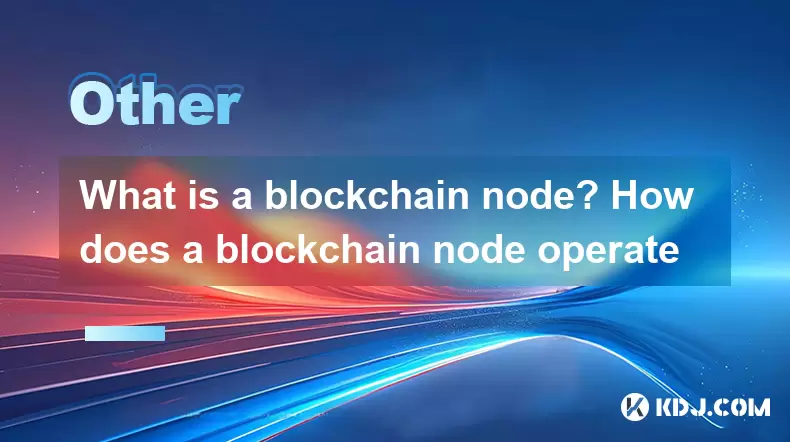
What Is a Blockchain Node?
A blockchain node is a fundamental component of any decentralized network. In simple terms, a node is a computer or device that participates in the operation of a blockchain by maintaining a copy of the distributed ledger and validating transactions. Each node contributes to the overall security, transparency, and decentralization of the blockchain system.
Nodes are essential because they store data, verify transactions, and relay information across the network. Without nodes, there would be no blockchain — it's the nodes that ensure consensus and prevent fraudulent activities.
Types of Blockchain Nodes
There are several types of nodes within a blockchain ecosystem, each serving a unique function:
Full Nodes: These nodes download the entire blockchain, validate all transactions, and enforce consensus rules. Full nodes are crucial for maintaining network integrity.
Lightweight (Light) Nodes: These nodes do not store the complete blockchain and rely on full nodes for transaction verification. They are commonly used in mobile wallets due to limited storage capacity.
Mining Nodes: These nodes participate in the mining process, which involves solving complex cryptographic puzzles to add new blocks to the chain. Mining nodes are typically associated with Proof-of-Work (PoW) blockchains like Bitcoin.
Staking Nodes: Also known as validator nodes, these operate in Proof-of-Stake (PoS) systems where users must lock up a certain amount of cryptocurrency to participate in block validation.
Masternodes: These nodes provide additional services beyond transaction validation, such as enabling private transactions or participating in governance decisions. Masternodes usually require a significant collateral investment.
Each type plays a specific role in supporting the decentralized nature of blockchain technology.
How Does a Blockchain Node Operate?
When a node joins a blockchain network, it begins by downloading the entire history of the blockchain from other nodes. This synchronization ensures that the new node has an accurate and up-to-date version of the ledger.
Once synchronized, the node performs several key functions:
Transaction Validation: When a user initiates a transaction, it is broadcast to the network. The node checks whether the transaction meets all consensus rules, including digital signatures and available funds.
Block Propagation: Validated transactions are grouped into blocks. Nodes relay these blocks to other nodes, ensuring that all participants receive the same updated ledger.
Consensus Participation: Depending on the blockchain’s consensus mechanism, nodes may vote, mine, or stake to agree on the next valid block.
Data Storage: Nodes store the blockchain data locally, making it accessible for future reference and audits.
These operations happen continuously, allowing the blockchain to remain functional, secure, and transparent.
Setting Up a Blockchain Node: Step-by-Step Guide
To run your own node, follow these detailed steps:
Choose the Type of Node You Want to Run: Decide whether you're setting up a full node, light node, staking node, or masternode based on your resources and goals.
Select the Appropriate Hardware and Software: Ensure your machine meets the minimum requirements, such as disk space, RAM, and bandwidth. Download the official client software for the blockchain you want to support.
Download and Install the Software: Follow the installation instructions provided by the blockchain project. For example, running a Bitcoin node requires downloading the Bitcoin Core wallet.
Open Necessary Ports on Your Router: To allow incoming connections, configure port forwarding on your router. Common ports include 8333 for Bitcoin.
Start the Synchronization Process: Launch the node software and allow it to download the entire blockchain. This can take hours or even days depending on your internet speed and hardware.
Verify Node Functionality: Use built-in tools or external explorers to confirm that your node is successfully validating and relaying transactions.
Running a node enhances network security and gives you greater control over your transactions.
Importance of Running a Node
Operating a node provides multiple benefits to both individuals and the broader blockchain ecosystem:
Increased Security: By running a node, you eliminate reliance on third-party services, reducing the risk of fraud or manipulation.
Privacy Protection: Full nodes allow users to verify transactions independently, preventing the need to disclose personal data to external entities.
Network Decentralization: More nodes mean a more distributed network, making it harder for malicious actors to compromise the system.
Contribution to Consensus: Nodes help maintain the integrity of the blockchain by enforcing rules and ensuring only valid transactions are accepted.
Individuals who operate nodes contribute directly to the resilience and reliability of the blockchain infrastructure.
Frequently Asked Questions
Can I Run Multiple Nodes on the Same Device?
Yes, it's technically possible to run multiple nodes on a single machine using virtual machines or containerization tools like Docker. However, this requires sufficient CPU, memory, and storage resources to handle concurrent operations without performance degradation.
Do All Blockchains Require Nodes?
All public blockchains depend on nodes to function. Private or permissioned blockchains may have fewer nodes controlled by specific organizations, but nodes remain essential for transaction validation and data storage regardless of the network type.
What Happens If a Node Goes Offline?
If a node disconnects temporarily, it will automatically resynchronize once reconnected. However, prolonged downtime might result in missed transactions or reduced contribution to consensus mechanisms, especially in staking or masternode scenarios.
Are There Any Risks Involved in Running a Node?
While running a node is generally safe, potential risks include increased electricity usage, exposure to cyberattacks if proper security measures aren't taken, and potential legal issues depending on local regulations regarding cryptocurrencies.
Disclaimer:info@kdj.com
The information provided is not trading advice. kdj.com does not assume any responsibility for any investments made based on the information provided in this article. Cryptocurrencies are highly volatile and it is highly recommended that you invest with caution after thorough research!
If you believe that the content used on this website infringes your copyright, please contact us immediately (info@kdj.com) and we will delete it promptly.
- BONK, Ethereum, and AI Utility: A New Era?
- 2025-06-21 12:25:12
- Bitcoin Price Prediction: Will BTC Bounce Back or Break Down?
- 2025-06-21 12:25:12
- BONK Price Prediction: Will the Meme Coin Rebound?
- 2025-06-21 12:30:12
- Bitcoin's $100K-$110K Range: Short Interest Heats Up!
- 2025-06-21 12:45:12
- CoinMarketCap Under Fire: Wallet Scam Highlights Malicious Activity
- 2025-06-21 12:45:12
- Meme Coins, Crypto, and Explosions: What's Poppin' in 2025?
- 2025-06-21 13:05:11
Related knowledge
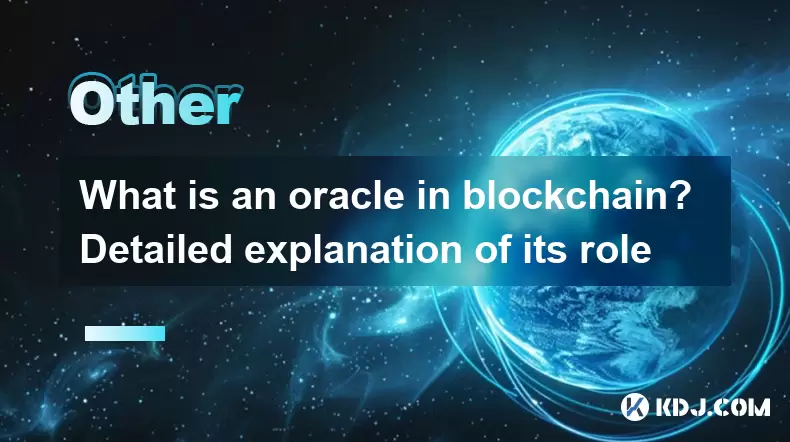
What is an oracle in blockchain? Detailed explanation of its role
Jun 21,2025 at 06:14am
Understanding the Concept of an Oracle in BlockchainIn the realm of blockchain technology, an oracle is a trusted third-party service that connects smart contracts with real-world data. Smart contracts are self-executing agreements where the terms are written directly into code and run on a blockchain network. However, these contracts operate in a close...
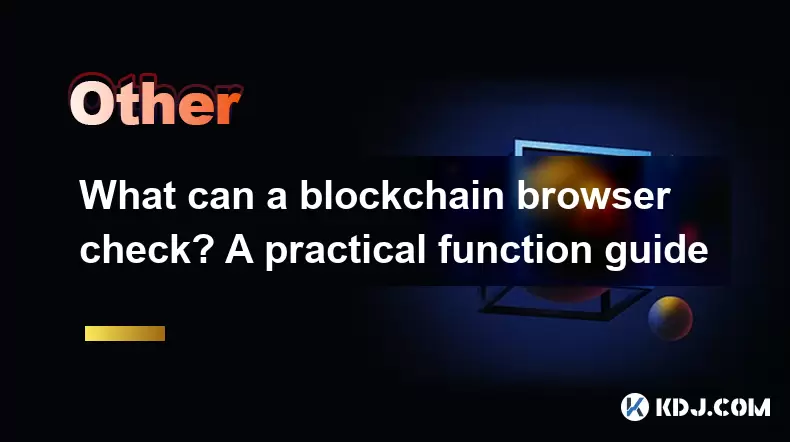
What can a blockchain browser check? A practical function guide
Jun 20,2025 at 07:35pm
Understanding the Role of a Blockchain BrowserA blockchain browser serves as a powerful tool for anyone interacting with blockchain networks. It allows users to explore, verify, and analyze data stored on the blockchain in real time. Unlike traditional ledgers or databases that are centralized, blockchains are decentralized and publicly accessible. This...
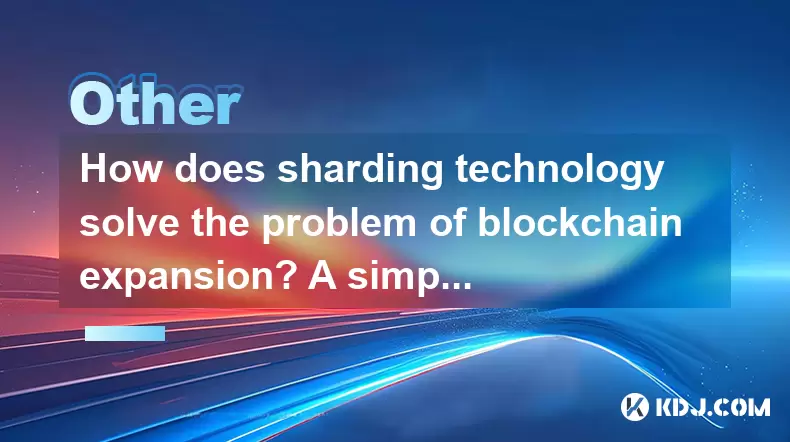
How does sharding technology solve the problem of blockchain expansion? A simple interpretation
Jun 20,2025 at 07:50am
Understanding the Scalability Problem in BlockchainThe blockchain scalability problem refers to the limitation of traditional blockchain networks like Bitcoin and Ethereum in processing a large number of transactions per second. Unlike centralized systems such as Visa, which can handle tens of thousands of transactions per second, most public blockchain...

What are the characteristics of the cryptocurrency bull market cycle? Data verification
Jun 19,2025 at 09:56pm
Understanding the Cryptocurrency Bull Market CycleThe cryptocurrency bull market cycle is a recurring phenomenon that investors and traders closely monitor. During such periods, prices of digital assets rise significantly over an extended time frame. A key characteristic of this cycle is increased investor confidence, often fueled by macroeconomic facto...
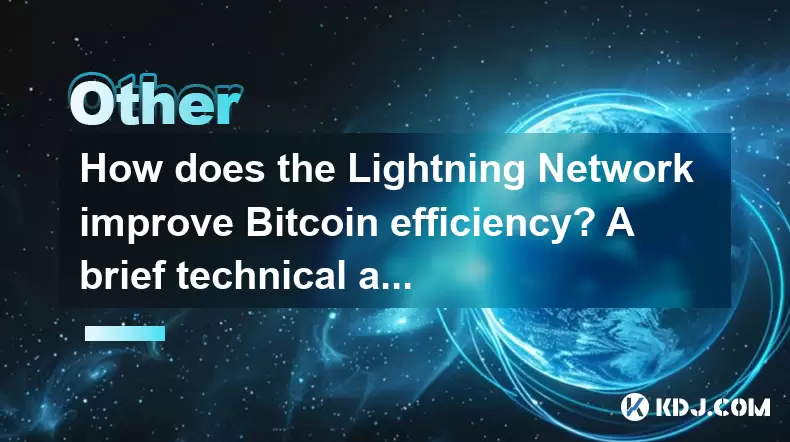
How does the Lightning Network improve Bitcoin efficiency? A brief technical analysis
Jun 21,2025 at 04:36am
Understanding the Bitcoin Scalability ProblemBitcoin, while revolutionary in terms of decentralized finance and peer-to-peer transactions, faces a fundamental scalability issue. The blockchain's limited block size and slow confirmation times hinder its ability to handle large volumes of transactions efficiently. Each block is mined approximately every 1...
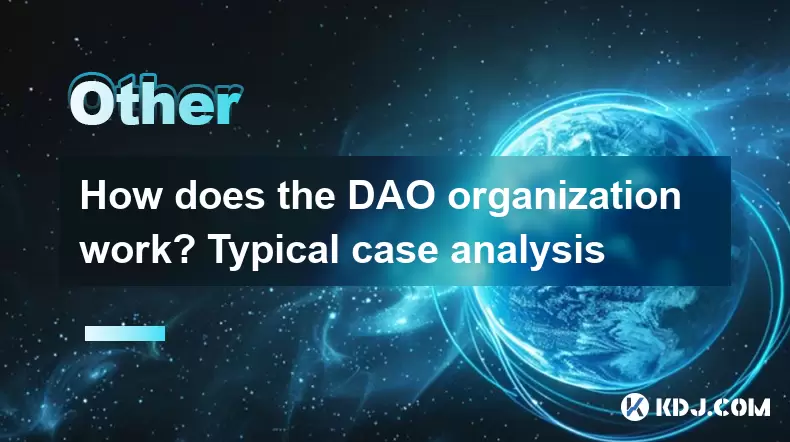
How does the DAO organization work? Typical case analysis
Jun 20,2025 at 02:56am
What is a DAO?A Decentralized Autonomous Organization (DAO) operates without centralized leadership, relying on smart contracts and community governance. These organizations are typically built on blockchain platforms like Ethereum, where rules are encoded into code. Members of a DAO usually hold tokens that grant them voting rights, allowing them to pr...

What is an oracle in blockchain? Detailed explanation of its role
Jun 21,2025 at 06:14am
Understanding the Concept of an Oracle in BlockchainIn the realm of blockchain technology, an oracle is a trusted third-party service that connects smart contracts with real-world data. Smart contracts are self-executing agreements where the terms are written directly into code and run on a blockchain network. However, these contracts operate in a close...

What can a blockchain browser check? A practical function guide
Jun 20,2025 at 07:35pm
Understanding the Role of a Blockchain BrowserA blockchain browser serves as a powerful tool for anyone interacting with blockchain networks. It allows users to explore, verify, and analyze data stored on the blockchain in real time. Unlike traditional ledgers or databases that are centralized, blockchains are decentralized and publicly accessible. This...

How does sharding technology solve the problem of blockchain expansion? A simple interpretation
Jun 20,2025 at 07:50am
Understanding the Scalability Problem in BlockchainThe blockchain scalability problem refers to the limitation of traditional blockchain networks like Bitcoin and Ethereum in processing a large number of transactions per second. Unlike centralized systems such as Visa, which can handle tens of thousands of transactions per second, most public blockchain...

What are the characteristics of the cryptocurrency bull market cycle? Data verification
Jun 19,2025 at 09:56pm
Understanding the Cryptocurrency Bull Market CycleThe cryptocurrency bull market cycle is a recurring phenomenon that investors and traders closely monitor. During such periods, prices of digital assets rise significantly over an extended time frame. A key characteristic of this cycle is increased investor confidence, often fueled by macroeconomic facto...

How does the Lightning Network improve Bitcoin efficiency? A brief technical analysis
Jun 21,2025 at 04:36am
Understanding the Bitcoin Scalability ProblemBitcoin, while revolutionary in terms of decentralized finance and peer-to-peer transactions, faces a fundamental scalability issue. The blockchain's limited block size and slow confirmation times hinder its ability to handle large volumes of transactions efficiently. Each block is mined approximately every 1...

How does the DAO organization work? Typical case analysis
Jun 20,2025 at 02:56am
What is a DAO?A Decentralized Autonomous Organization (DAO) operates without centralized leadership, relying on smart contracts and community governance. These organizations are typically built on blockchain platforms like Ethereum, where rules are encoded into code. Members of a DAO usually hold tokens that grant them voting rights, allowing them to pr...
See all articles

























































































